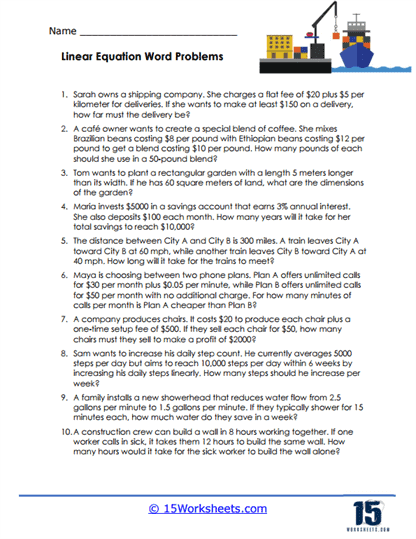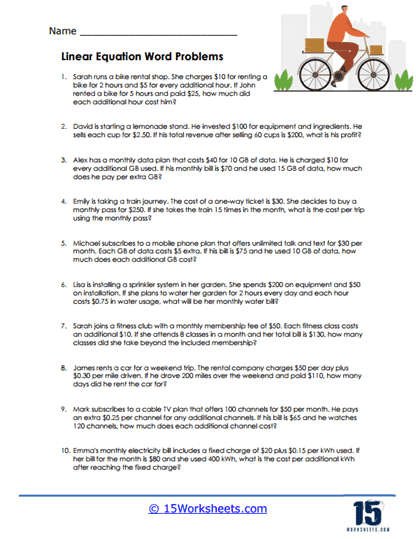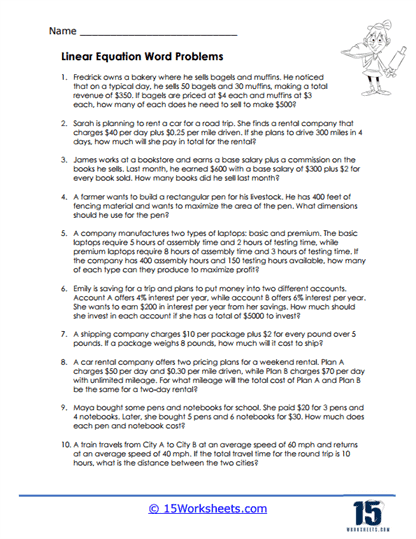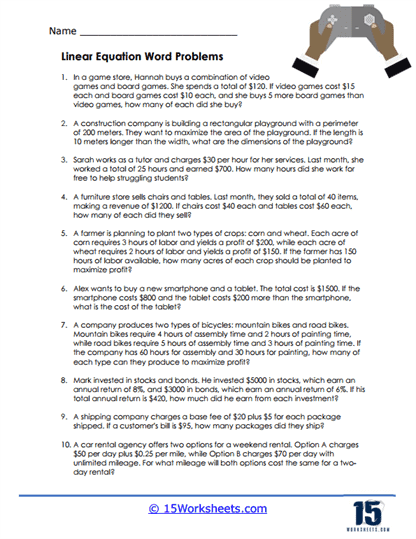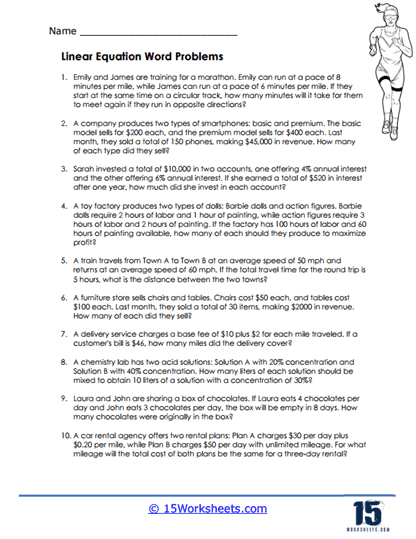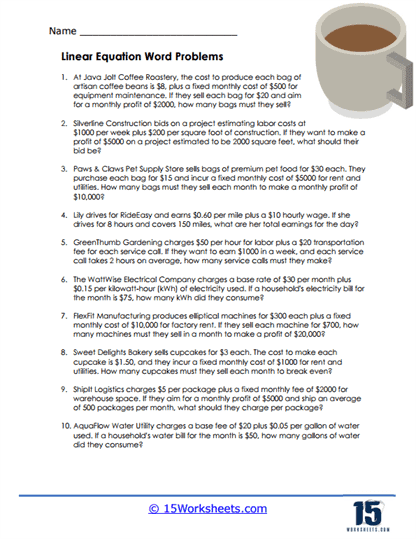Linear Equation Word Problems Worksheets
About These 15 Worksheets
These worksheets were created to help students understand and apply the concepts of linear equations to solve real-world problems. The worksheets present various scenarios where students must create and solve linear equations to find solutions. By practicing with these worksheets, students can enhance their problem-solving skills and see the practical applications of linear equations in everyday life.
These worksheets include a variety of problems that involve financial situations, motion and distance, mixtures, geometry, and interpreting graphs and tables. By practicing with these worksheets, students can improve their problem-solving skills, see the practical applications of linear equations, develop a deeper understanding of the subject, and enhance their ability to communicate mathematically. Additionally, these worksheets provide opportunities for collaborative learning and help students develop persistence and resilience. As a result, linear equation word problem worksheets play a crucial role in students’ mathematical education, helping them develop the skills and knowledge they need to succeed in their future studies and careers.
On a typical linear equation word problem worksheet, you would expect to see a range of problems that involve different contexts and require students to form and solve linear equations. These problems often cover diverse topics such as finance, motion, mixtures, and geometry. Each problem provides a real-world scenario where students must identify the variables, set up an equation, and solve for the unknown.
One common type of problem involves financial situations. For instance, students might encounter problems related to budgeting, savings, or investments. A problem might describe a scenario where a person saves a certain amount of money each month and asks how long it will take to reach a savings goal. Students would need to set up a linear equation where the total savings is a function of the monthly savings and the number of months. For example, if someone saves $200 per month and wants to save $2,000, the equation would be 200 x = 2000, where x represents the number of months. Solving this equation helps students understand how to manage money and plan for financial goals.
Another common type of problem involves motion and distance. These problems often describe scenarios where an object or person is moving at a constant speed, and students must find the time, distance, or speed. For example, a problem might state that a car travels at a speed of 60 miles per hour and asks how long it will take to travel 180 miles. Students would set up the equation 60 x = 180, where x represents the time in hours. Solving this equation helps students understand the relationship between speed, distance, and time, which is crucial for planning travel and understanding motion.
Linear equation word problem worksheets also include mixture problems, which involve combining different substances to achieve a desired mixture. For instance, a problem might describe a scenario where a chemist needs to mix solutions of different concentrations to achieve a specific concentration. If a chemist has a 10% solution and a 30% solution and needs to create 100 milliliters of a 20% solution, students would set up the equation 0.10x + 0.30(100 – x) = 0.20 x 100, where x represents the amount of the 10% solution. Solving this equation helps students understand the principles of concentration and mixing, which are important in chemistry and various industries.
Problems involving geometry are also common on linear equation word problem worksheets. These problems often require students to find the dimensions of geometric shapes based on given conditions. For example, a problem might describe a rectangle where the length is twice the width and the perimeter is 36 units. Students would set up the equations 2x+2(2x)=36 and solve for x, where x represents the width of the rectangle. Solving these problems helps students understand the relationships between different geometric properties and how to apply algebraic methods to geometry.
In addition to these specific types of problems, linear equation word problem worksheets often include problems that require students to interpret graphs and tables. Students might be given a graph that represents a linear relationship and asked to write the equation of the line, or they might be given a table of values and asked to find the linear equation that fits the data. These problems help students understand how to represent and interpret linear relationships visually and numerically, which is a key skill in data analysis and various fields of study.
Practicing with linear equation word problem worksheets can significantly improve students’ understanding of real-world math. These worksheets help students develop critical thinking and problem-solving skills by requiring them to analyze real-world situations, identify relevant information, and create and solve equations. This process encourages students to think logically and methodically, which is essential for success in mathematics and other disciplines.
One of the key benefits of practicing with these worksheets is that they help students see the practical applications of linear equations. By working through problems that relate to everyday life, students understand how algebraic concepts can be used to solve real-world problems. This understanding makes the subject more relevant and engaging, which can increase students’ motivation and interest in learning math.
Practicing with these worksheets helps students develop a deeper understanding of linear equations and their properties. By solving a variety of problems, students learn how to manipulate equations, work with variables, and understand the relationships between different quantities. This knowledge is fundamental for more advanced topics in mathematics, such as calculus and differential equations, and is also useful in fields such as science, engineering, economics, and social sciences.
These worksheets also help students improve their ability to communicate mathematically. By working through word problems, students learn how to interpret and translate verbal descriptions into mathematical equations, which is a crucial skill for solving complex problems and communicating solutions effectively. This skill is important not only for academic success but also for professional and everyday situations where clear and accurate communication of mathematical ideas is needed.
These types of worksheets provide opportunities for collaborative learning. Students can work together to solve problems, discuss different approaches, and share their reasoning. This collaboration can lead to a deeper understanding of the concepts and the development of teamwork and communication skills. Teachers can facilitate group discussions and encourage students to explain their thought processes, fostering a collaborative and supportive learning environment.
These worksheets help students develop persistence and resilience. Solving word problems often requires multiple steps and careful reasoning, which can be challenging. By working through these problems and overcoming difficulties, students learn to persevere and develop confidence in their problem-solving abilities. This persistence is valuable for success in mathematics and other areas of life where challenges and complex problems are common.
Example of a Linear Equation Word Problem
Problem: A gym offers two membership plans. Plan A charges a flat fee of $50 per month. Plan B charges a flat fee of $30 per month plus an additional $2 for each visit to the gym. How many visits per month would make Plan B more expensive than Plan A?
Solution
Step #1 – Define the variables:
Let x represent the number of visits to the gym per month.
Step #2 – Write the cost equations for both plans:
Plan A: CostA = 50
Plan B: CostB = 30 + 2x
Step #3 – Set up the inequality to determine when Plan B is more expensive than Plan A:
30 + 2x > 50
Step #4 – Solve the inequality for x:
Subtract 30 from both sides: 2x > 20
Divide both sides by 2: x > 10
Step #5 – Interpret the solution:
Plan B will be more expensive than Plan A if the number of visits per month exceeds 10. Plan B becomes more expensive than Plan A when there are more than 10 visits per month.

